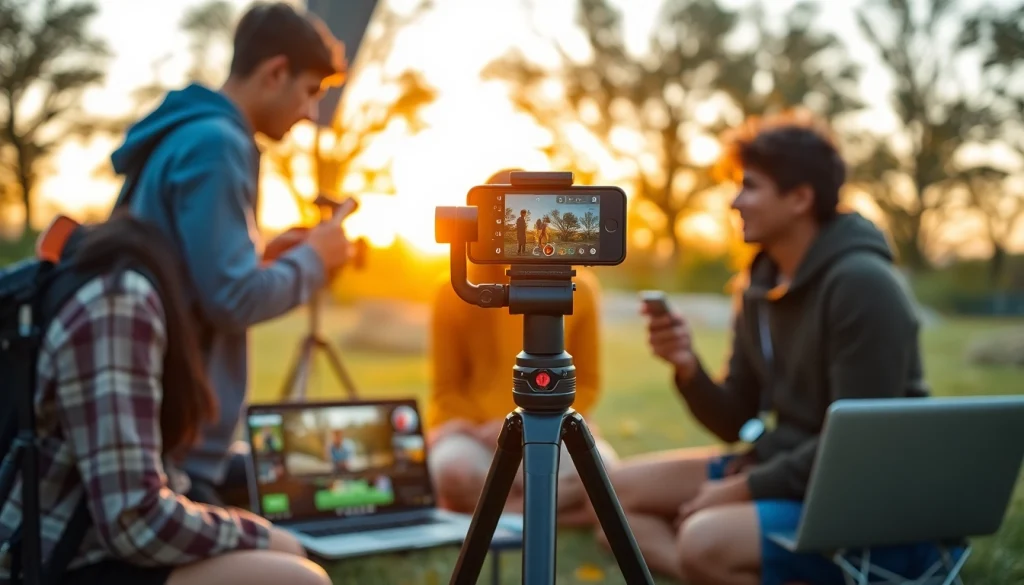Essential Smartphone-Gimbal Techniques for Captivating Videos in 2025

Understanding Smartphone-Gimbals: A Comprehensive Overview
In the fast-evolving world of mobile videography, smartphone gimbals have emerged as essential tools for aspiring filmmakers, vloggers, and content creators. These innovative devices not only stabilize camera movements but also enable users to achieve cinematic effects that were once reserved for high-end equipment. For anyone looking to enhance their videography skills, understanding the Smartphone-Gimbal is crucial. This article will delve into the intricacies of smartphone gimbals, exploring their functionalities, advantages compared to traditional stabilizers, and best practices for effective use.
What is a Smartphone-Gimbal and How Does it Work?
A smartphone gimbal is a handheld stabilizer that utilizes motorized controls to manage the movement of your smartphone while shooting video. By automatically counteracting unwanted motions, a gimbal ensures your footage remains smooth and professional, regardless of the filming environment. This technology leverages a series of gyroscopes and accelerometers to detect the orientation of the device and make real-time adjustments to maintain stability.
Gimbals typically operate on three axes: yaw, pitch, and roll. The yaw axis helps in horizontal movements, pitch stabilizes vertical movements, and roll is responsible for keeping the horizon level. This multidimensional stabilization allows creators to capture dynamic shots, including pans, tilts, and tracking moves, without the typical shakiness found in handheld footage.
Key Features to Look for in a Smartphone-Gimbal
- Stabilization Technology: Look for 3-axis stabilization for optimal smoothness.
- Payload Capacity: Ensure the gimbal can support your smartphone’s weight alongside any additional accessories.
- Battery Life: Choose a gimbal that offers extended battery performance for longer shooting sessions.
- Build Quality: A sturdy, lightweight design is essential for portability and durability.
- Smart Features: Consider gimbals with features like object tracking, time-lapse, and motion control for enhanced creative options.
Comparative Advantages Over Traditional Stabilizers
Traditional stabilizers, such as steady cams, have long been used in professional filmmaking, offering minimal shake in videos. However, smartphone gimbals present several distinct advantages:
- Portability: Gimbals are significantly lighter and compact, making them ideal for on-the-go filming.
- Ease of Use: With intuitive controls and quick setup, gimbals cater to all skill levels, from beginners to professionals.
- Versatility: They offer more dynamic functionality, including panning and tracking shots, which can be more challenging with traditional gear.
- Affordability: Many smartphone gimbals are budget-friendly, making high-quality stabilization accessible to a broader audience.
Top Smartphone-Gimbal Models of 2025
Best Overall Smartphone-Gimbal Options on the Market
As of 2025, several smartphone gimbals stand out in the market for their performance and features. The DJI OM6 is highly regarded for its superior stabilization capabilities and user-friendly app integration, while the Zhiyun Smooth 5 offers exceptional payload capacity, facilitating the use of additional lenses or accessories.
Budget-Friendly Smartphone-Gimbals for Beginners
For those new to videography, budget-friendly options do not compromise quality. The Hohem iSteady V3 offers impressive stabilization features at a lower price point, perfect for casual users. Another great choice is the FeiyuTech VLOG pocket, which is compact and easy to use, making it a popular entry-level gimbal.
High-End Smartphone-Gimbals for Professional Filmmakers
Professionals looking to leverage cutting-edge technology should consider the Zhiyun Crane M3 or the Moza Mini-P. Both gimbals provide advanced stabilization, extensive battery life, and customizable controls, catering to the intricate needs of high-end productions.
Best Practices for Using a Smartphone-Gimbal Effectively
Setup Tips for Optimal Stability and Movement
To maximize the effectiveness of your smartphone gimbal, proper setup is paramount. Always ensure your smartphone is securely mounted and balanced before turning on the gimbal. This prevents unnecessary strain on the motors and enhances stabilization. Additionally, familiarize yourself with the gimbal’s controls, as each model may have unique features that can streamline your shooting process.
Common Mistakes to Avoid When Using a Gimbal
- Neglecting Calibration: Always calibrate your gimbal before use to ensure accurate stabilization.
- Excessive Movements: Avoid rapid or jerky movements, which can negate stabilization benefits.
- Inadequate Battery Monitoring: Always check battery levels before shooting to avoid interruptions during filming.
Creative Techniques to Enhance Your Video Quality
Utilize the gimbal’s capabilities to create visually engaging content. Techniques such as establishing shots with smooth pans, following subjects with dynamic tracking, and experimenting with height changes can significantly elevate your videography. Incorporating storytelling elements while utilizing these techniques can further engage your audience.
Real-World Applications and Success Stories
Case Studies of Filmmakers Utilizing Smartphone-Gimbals
Many filmmakers have found success using smartphone gimbals to create stunning content. For example, filmmaker Ava Lu showcased the capabilities of the DJI OM6 in her short film “Urban Motion,” where she combined time-lapse sequences with smooth tracking shots to narrate a story about city life.
Impact of Gimbal Stabilization on Viewer Engagement
Research indicates that smooth, stable footage significantly enhances viewer engagement. Content creators who incorporate gimbals report higher watch times and interacting rates, as audiences find polished visuals more appealing. By investing in a smartphone gimbal, creators can improve their production quality, leading to greater audience retention.
Viral Video Trends Using Smartphone-Gimbals in Content Creation
Many viral trends have begun with the use of smartphone gimbals, particularly in platforms like TikTok and Instagram. For instance, the “gimbal dance challenge” sees creators performing choreographed dances with smooth transitions and camera movements, showcasing the gimbal’s capabilities while engaging audiences in fun ways.
The Future of Smartphone-Gimbals and Filmmaking Technology
Emerging Trends in Gimbal Technology by 2025
The gimbal market is evolving with advancements in technology. With the integration of AI capabilities, future gimbals will feature more intelligent tracking and stabilization systems, adapting to user movements in real time and providing enhanced shooting experiences.
Integrating AI and Automation with Smartphone-Gimbals
As AI technology progresses, future gimbals may come equipped with features such as automatic focus and scene detection, allowing for effortless shooting adjustments. This automation will cater to both amateur and professional videographers, streamlining the filming process and reducing the knowledge barrier for effective videography.
Predictions for the Next Generation of Mobile Videography
The future of mobile videography is bright, with potential developments including integrated editing tools within gimbals and seamless connectivity with drones for aerial shots. As smartphone technology continues to improve, so too will the capabilities of gimbals, ensuring that creators have the tools necessary to produce high-quality, engaging content in an increasingly visual digital landscape.






